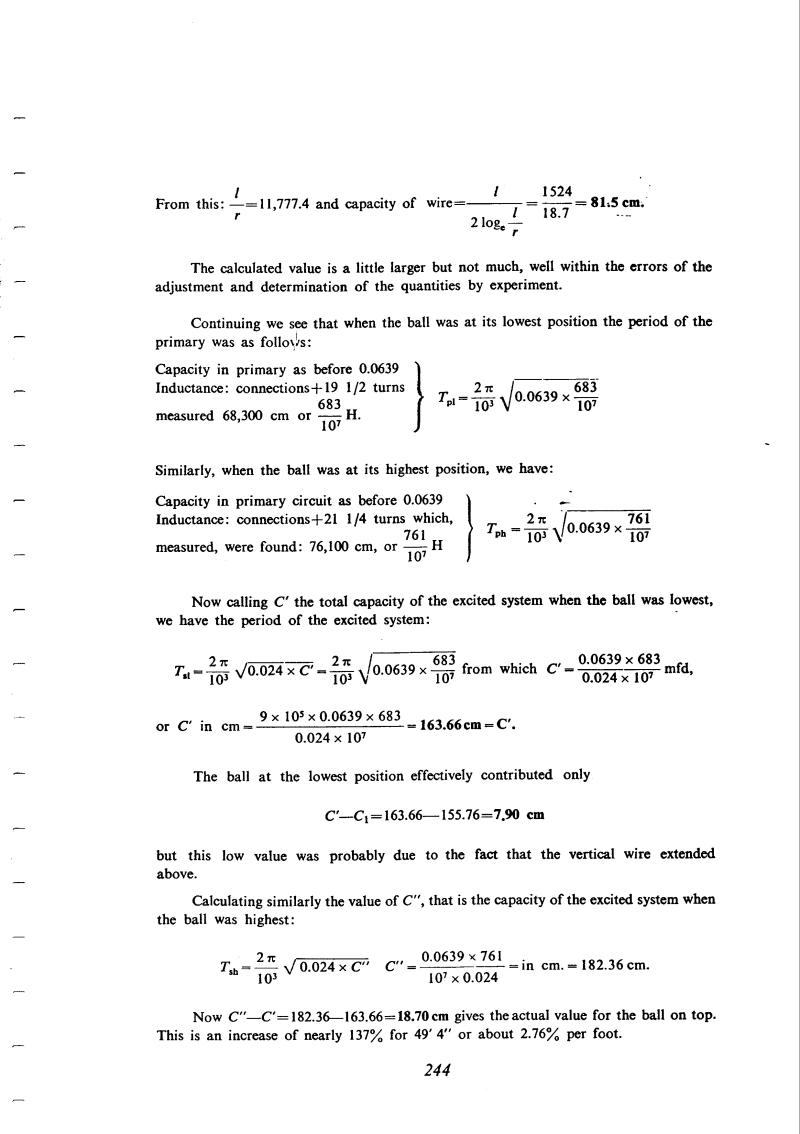
Nikola Tesla Books
From this: $! {l \over r} $! = 11,777.4 and capacity of wire = $! {{l \over {2 \log_{e}{l \over r}}} = {1524 \over 18.7} =} $! 81.5 cm.
The calculated value is a little larger but not much, well within the errors of the adjustment and determination of the quantities by experiment.
Continuing we see that when the ball was at its lowest position the period of the primary was as follows:
| Capacity in primary as before 0.0639 Inductance: connections + 19 1/2 turns measured 68,300 cm or $! {{683 \over 10^{7}} H} $!. |
} | $! {{T_{p}}_{l} = {{2 \pi \over 10^{3}} \sqrt{0.0639 \times {683 \over 10^{7}}}}} $! |
Similarly, when the ball was at its highest position, we have:
| Capacity in primary circuit as before 0.0639 Inductance: connections + 21 1/24 turns which, measured, were found: 76,100 cm or $! {{761 \over 10^{7}} H} $! |
} | $! {{T_{p}}_{h} = {{2 \pi \over 10^{3}} \sqrt{0.0639 \times {761 \over 10^{7}}}}} $! |
Now calling C' the total capacity of the excited system when the ball was lowest, we have the period of the excited system:
$! {{T_{s}}_{l} = {{2 \pi \over 10^{3}} \sqrt{0.024 \times C'}} = {{2 \pi \over 10^{3}} \sqrt{0.0639 \times {683 \over 10^{7}}}}} $! from which $! {C' = {{0.0639 \times 683} \over {0.024 \times 10^{7}}}} $!,
or C' in cm = $! {{9 \times 10^{5} \times 0.0639 \times 683} \over {0.024 \times 10^{7}}} $! = 163.66 cm = C'.
The ball at the lowest position effectively contributed only
C' - C1 = 163.66 - 155.76 = 7.90 cm
but this low value was probably due to the fact that the vertical wire extended above.
Calculating similarly the value of C", that is the capacity of the excited system when the ball was highest:
$! {{T_{s}}_{h} = {2 \pi \over 10^{3}} \sqrt{0.024 \times C''}} $! $! {C'' = {{0.0639 \times 761} \over {10^{7} \times 0.024}} =} $! in cm. = 182.36 cm.
Now C'' - C' = 182.36 - 163.66 = 18.70 cm gives the actual value for the ball on top. This is an increase of nearly 137% for 49' 4" or about 2.76% per foot.
244
October 28
After several days gathering data and making further measurements of inductance and capacitance, he finally proceeds to the calculation of the unknown capacity of the sphere, using the readings of October 23rd and 26th. Consistent with his general principle, he checked the measured values by (usually approximate) calculations.
He calculates the capacitance of the vertical wire by the formula for an isolated ellipsoid of high eccentricity. It is not known whether Tesla first had the idea of using this formula, but it was used later for a similar purpose(58). All things considered, the agreement between the calculated and measured values is very good.
Tesla then calculated the ratio of the capacities in the lowest and highest positions. In the lowest position the sphere makes little difference to the total capacity. In the highest position it increases the capacity in the coil circuit by 18.7 cm. This is less than the theoretical value for an isolated sphere of 18" diameter, which does not agree with some of his earlier measurements (see the results of October 21st for a 30" ball). However, if a comparison is to be made, it must be noted that the new results are probably better because the apparatus had been modified and the parameters checked.
October 28
After collecting data for several days and performing additional measurements of inductance and capacitance, he finally calculated the known sphere capacitance. He takes the values measured on Oct. 23 and 26. Following his working method he checks the measured values (most frequently approximate ones) by calculation.
The vertical wire capacitance he calculates by means of the equation for the single elipsoid capacitance with high axis ratio. We don't know where Tesla came up with the idea to use this equation but it is known that it has been applied later for a similar purpose(58). Based on all these circumstances, the matching between measure and calculated value is indeed very good. Further calculations are related to sphere capacitance in the lowest and highest elevation. In the lowest position the sphere contributes very little to the capacitance increase. In the highest position the globe increases the capacitance in coil L circuit by 18.7 cm. This value is smaller than the theoretical capacitance value for the separate sphere of 18" diameter, which does not correspond with some previous Tesla measurements (please see results of Oct. 21 for a globe 30" in diameter). When we compare the results, it has to be emphasized that the new results are likely better because measurements were performed with changed apparatus and checked parameters.

